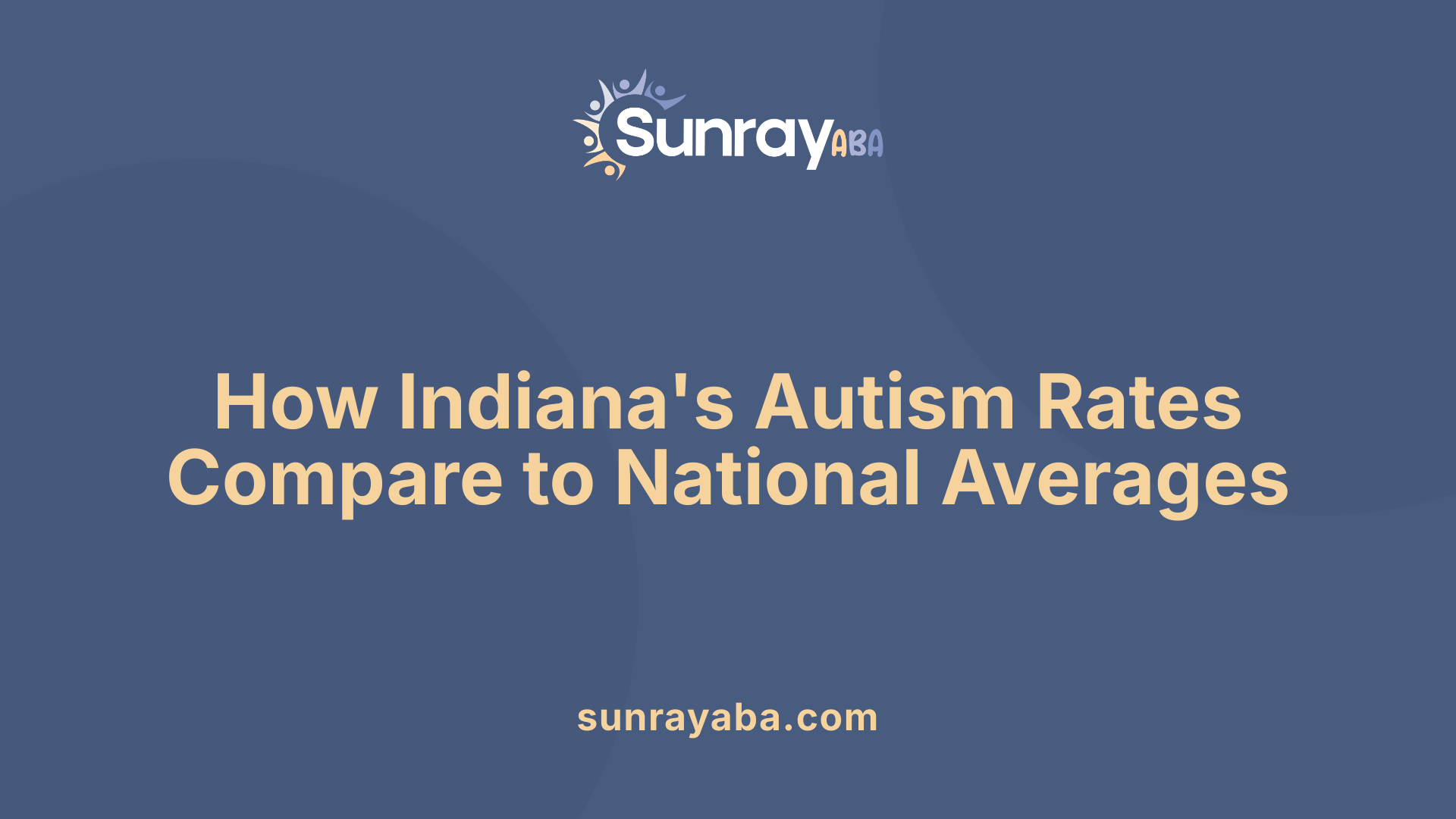Autism Prevalence In Indiana

Understanding Autism Prevalence in Indiana
Autism spectrum disorder (ASD) is increasingly recognized across the United States, and Indiana is no exception. As awareness grows, so does the importance of understanding the prevalence, regional differences, and available support for affected families. This article explores recent statistics, trends, demographic variations, and resources specific to Indiana, providing a comprehensive overview of autism within the state.
Current Autism Prevalence Rates in Indiana and Their Comparison to the National Level

What is the autism prevalence rate in Indiana and how does it compare to the national average?
In Indiana, recent data shows a fluctuation in autism prevalence among children, reflecting the ongoing efforts in awareness, diagnosis, and reporting mechanisms. Based on the most current school enrollment data, the autism prevalence rate in Indiana has slightly decreased from 1 in 62 last year to approximately 1 in 66 this year. This trend suggests a steady recognition of autism spectrum disorder (ASD) within the school-aged population.
The statewide autism prevalence rate in Indiana has been quantified at about 1.09% in 2021, aligning closely with national estimates. The Centers for Disease Control and Prevention (CDC) reports that the overall autism prevalence in the United States is around 1 in 44 children, which equates to approximately 2.3%. This national figure is derived from surveillance of children aged 4 and 8 years across various sites, including Indiana.
Historical data from Indiana provides insight into trends over time. For example, in 2018, the autism prevalence among 8-year-olds was reported as 1 in 67, which is quite similar to recent figures. These slight fluctuations are normal as diagnostic criteria, screening practices, and awareness evolve.
When comparing Indiana to the U.S. overall, the state's current autism rates are very close to the national average. The slight differences seen over the past few years are likely due to improvements in early detection and increased access to diagnostic services, rather than a true difference in occurrence.
Overall, Indiana's autism prevalence is comparable to national figures, with recent data indicating a rising trend in diagnosis rates. This trend reflects growing awareness and improved diagnosis rather than an actual increase in the number of children with autism.
How does the prevalence in Indiana compare to national data?
Based on the latest available data, Indiana's autism prevalence is slightly below or on par with the national average across multiple measures. The state's ongoing surveillance efforts, including the Indiana Autism Spectrum Disorder Needs Assessment and school-based data collection, reinforce the consistency of this pattern.
The prevalence rate of 1 in 66 or approximately 1.5% signifies a significant portion of children affected by ASD, aligning with the national estimate of roughly 2.3%. The close alignment confirms that Indiana's experience with autism is representative of the broader U.S. landscape.
| Data Source | Prevalence Rate | Year | Notes |
|---|---|---|---|
| Indiana Department of Education | 1 in 66 | 2022 | School Enrollment Data |
| CDC | 1 in 44 | 2023 | National Average |
| Indiana Department of Education | 1 in 68 | 2014 | Child Count Data |
| Indiana Autism Needs Assessment | 1.09% | 2021 | Local survey |
This table summarizes key data points, illustrating the evolution and consistency of autism prevalence estimates in Indiana compared to national data.
Resources and Support Systems Building a Better Future for Families

What resources and support services are available for families affected by autism in Indiana?
Families living with autism in Indiana have access to a wide array of services and programs designed to support their needs. These resources aim to empower families, improve quality of life, and foster an inclusive community.
One prominent organization is the Autism Society of Indiana. This organization provides direct care services, helping families navigate the challenges of autism. They also organize educational events, such as Autism 101 sessions, which offer crucial information about autism spectrum disorder (ASD). Additionally, they promote autism-friendly activities, including sensory bags at local attractions and inclusive holiday celebrations that encourage community participation.
The Indiana Resource Center for Autism plays a vital role in providing educational programs and skills training. They support individuals with autism and their families across different settings, ensuring access to meaningful learning and development opportunities.
Several organizations offer personalized assistance tailored to family needs. Indiana Family to Family provides one-on-one support, guidance, and training, helping families understand and manage autism-related issues. Similarly, Damar offers respite care services and financial aid, easing the caregiving burden for many.
Advocacy groups like the Indiana Autism Alliance are instrumental in raising awareness and promoting acceptance. They support families through advocacy, organize community events, and foster peer support groups, creating a network of understanding and shared experience.
These combined efforts reflect Indiana’s commitment to supporting individuals with autism and their families. By offering diverse programs and fostering community engagement, Indiana helps families build a stronger, more inclusive future.
| Organization | Services Provided | Additional Notes |
|---|---|---|
| Autism Society of Indiana | Direct care, educational events, autism-friendly activities | Focused on community engagement |
| Indiana Resource Center for Autism | Education, skills support, diverse settings | Statewide outreach |
| Indiana Family to Family | Personalized support, guidance, training | Empowers families through tailored assistance |
| Damar | Respite care, financial assistance | Supports caregiver well-being |
| Indiana Autism Alliance | Advocacy, community events, support groups | Promotes awareness and acceptance |
This extensive network of organizations and services underscores Indiana’s dedication to creating a supportive environment for families impacted by autism, ensuring they have the tools and community support necessary for their journey.
Factors Influencing Autism Prevalence in Indiana and Potential Drivers

What are the factors influencing autism prevalence rates in Indiana?
The autism prevalence rate in Indiana has seen notable updates over recent years. As of 2021, the reported rate was approximately 1.09%, or about 1 in 66 children, according to school enrollment data. This slight variation from earlier figures, such as 1 in 62 based on the December 1 child count, suggests ongoing monitoring and possible shifts in detection or reporting practices.
Multiple factors contribute to the observed prevalence rates of autism in Indiana. Genetic predispositions are a primary influence, with autism tending to run in families. Families with one child diagnosed with ASD often have a higher chance of additional children being diagnosed, indicating a hereditary component.
Environmental factors also play a significant role. Research indicates that prenatal exposure to pollutants such as air pollution, pesticides, and maternal health conditions—including gestational diabetes or infections—can increase the risk of autism. Birth complications and maternal health during pregnancy are additional considerations.
Diagnostic practices and social awareness heavily influence reported prevalence figures. In Indiana, increased awareness among healthcare providers and the public has enhanced the detection of autism, especially as screening tools like the Modified Checklist for Autism in Toddlers (M-CHAT) become more widely used.
Regional differences in access to diagnostic and intervention services also affect observed rates. Organizations like the Indiana Resource Center for Autism work to improve awareness and services, which can lead to higher reporting as more children are accurately identified.
Changes in diagnostic criteria over time, aligned with updates from the Diagnostic and Statistical Manual of Mental Disorders (DSM), along with improved screening and assessment tools, have made diagnosing autism more reliable and earlier. The average age of diagnosis in Indiana is 5.5 years, with some diagnoses occurring as early as age 2.
Demographics within Indiana highlight that approximately 77.4% of families with children on the spectrum are White/Caucasian, although children from diverse racial and ethnic backgrounds are also affected. The regional data from the Indiana Department of Education supports these demographics.
Overall, the interplay between genetic susceptibility, environmental exposures, diagnostic practices, social awareness, and regional resource availability shapes the autism prevalence landscape in Indiana. Continued research and surveillance are vital to understanding and addressing these contributing factors comprehensively.
| Factor Type | Description | Impact on Prevalence |
|---|---|---|
| Genetic Factors | Hereditary predispositions and family history | Significant, increases risk in families |
| Environmental Influences | Prenatal exposure to pollutants, maternal health, birth complications | Contributes to increased risk |
| Diagnostic Practices | Use of screening tools, awareness campaigns, criteria updates | Affects detection and reported rates |
| Social Factors | Access to healthcare, regional resource availability, public awareness | Influences identification and reporting |
Understanding these various drivers helps shape strategies to support affected individuals and improve early detection efforts in Indiana.
Trends and Changes Over Time in Indiana’s Autism Landscape
What trends or changes have been observed in autism prevalence over time in Indiana?
Autism spectrum disorder (ASD) prevalence in Indiana has shown a gradual increase over recent years, mirroring national patterns. Data from multiple sources reveal notable shifts in diagnosed cases, highlighting evolving diagnostic practices and increased awareness.
In terms of specific figures, the Indiana Department of Education’s child count data reported an autism prevalence rate of approximately 1 in 62 children following 2020. More recent school enrollment data indicated a slight rise, with a prevalence rate of about 1 in 66 students. This trend suggests more children are being diagnosed, perhaps owing to better screening and heightened awareness among families and healthcare providers.
The Autism and Developmental Disabilities Monitoring (ADDM) Network's surveillance data further supports these findings, capturing trends across various sites, including Indiana. The overall rate in Indiana was around 1.09% in 2021, emphasizing a steady increase compared to previous years.
Early identification remains a priority, as the average age of diagnosis in Indiana is approximately 5.5 years. Many children are diagnosed as early as age 2, although the average age indicates some diagnoses occur later.
These upward trends could be influenced by multiple factors. Enhanced understanding of ASD, improved screening protocols, and expanded access to diagnostic services have likely contributed to more children being identified at younger ages.
Furthermore, disparities in diagnosis among racial, ethnic, and socioeconomic groups continue to be monitored. The majority of diagnosed individuals are White/Caucasian (about 77.4%), but efforts are ongoing to ensure equitable access to diagnosis for all populations.
In summary, Indiana’s autism landscape has evolved with increasing prevalence rates, driven by both actual increases and improved detection. This ongoing trend underscores the importance of continued research, resource allocation, and awareness campaigns to support individuals with autism and their families.
Demographic and Regional Disparities in Autism Diagnosis within Indiana
Are there demographic or regional differences in autism diagnosis within Indiana?
Within Indiana, autism diagnosis rates show significant variation across different demographic and regional lines. These disparities are shaped largely by differences in access to healthcare, socioeconomic factors, and geographic location.
Minority racial and ethnic groups, including those who speak different languages or come from diverse cultural backgrounds, frequently encounter obstacles to early evaluation and diagnosis. These challenges can result from limited healthcare resources, language barriers, or less awareness about autism spectrum disorder (ASD) symptoms.
Regionally, rural communities in Indiana tend to experience delays in diagnosing autism compared to their urban counterparts. Limited availability of specialized services and fewer healthcare providers trained in autism assessment contribute to these late diagnoses.
Factors Influencing Diagnosis Disparities
| Factor | Impact | Explanation |
|---|---|---|
| Healthcare Access | Reduced access delays diagnosis | Rural and underserved areas lack specialized clinics |
| Socioeconomic Status | Low income affects early evaluation | Financial and transportation barriers |
| Cultural & Language Barriers | Cultural differences may hinder recognition of symptoms | Variations in understanding and responding to autism signs |
Initiatives to Reduce Disparities
To combat these gaps, Indiana has initiated several programs. The Indiana Early Autism Evaluation Hub System aims to streamline access to autism testing and reduce wait times. Additionally, targeted training programs for primary care providers help improve early detection in diverse settings.
Community engagement efforts and the development of culturally sensitive evaluation tools are also in progress. These steps are crucial in ensuring that children from all backgrounds and regions receive timely and accurate diagnoses.
Moving Toward Equitable Autism Diagnosis
Achieving fairness in autism detection involves combining healthcare improvements, community outreach, and tailored resources. Indiana’s ongoing efforts highlight the importance of addressing disparities to ensure all children have the opportunity for early intervention and support.
| Disparity Type | Current Status | Focus Areas | Key Initiatives |
|---|---|---|---|
| Racial/Ethnic | Underdiagnosis in minorities | Cultural Competence | Culturally adapted evaluation tools |
| Regional | Delayed diagnosis in rural areas | Healthcare access | Indiana Early Autism Evaluation Hub System |
| Socioeconomic | Diagnosis delays due to resource gaps | Financial support | Outreach and education programs |
This targeted approach is essential to create an environment where every child in Indiana can be diagnosed early, regardless of their race, ethnicity, or geographic location.
Enhancing Understanding and Support for Autism in Indiana
The increasing prevalence of autism in Indiana underscores the importance of continued research, resource development, and community engagement. Efforts to improve diagnostic practices, address disparities, and expand support services are vital for ensuring that individuals with autism and their families receive the care, education, and resources they need to thrive. As awareness and understanding grow, Indiana is poised to foster a more inclusive environment that recognizes the diverse needs of its autism community.
References
- Facts & Statistics - Autism Society of Indiana
- Prevalence and Early Identification of Autism Spectrum - CDC
- [PDF] Indiana Autism Spectrum Disorder Needs Assessment
- Autism Rates by State 2025 - World Population Review
- Booklet: After the Diagnosis of an Autism Spectrum Disorder: A ...
- National and State Estimates of Adults with Autism Spectrum Disorder
- Autism Rates by State 2025 - World Population Review
- Autism Data Visualization Tool | Autism Spectrum Disorder (ASD)